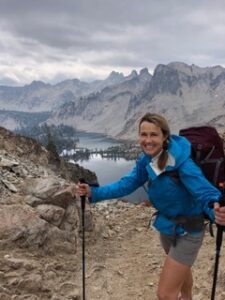BY DANA DUGAN

We are adventurous, physical people. We recreate. We hike, ski, bike, and board. The Wood River Valley stands out as not just a sporty place but a haven for body workers. Hardcore recreationalists do suffer injuries. Healers of varied ilk are in high demand. Other than straight-forward physical therapists, there are many body workers who practice alternative forms of self-healing, from yoga and its associated health care, Ayurveda, to acupuncture, Reiki and Rolfing.
The Japanese therapy Reiki is administered by laying hands either lightly upon one or hovering just above. This is done to facilitate a healing flow of energy, in a similar way to acupuncture or acupressure. A gentle, unobtrusive form or therapy that could not be more different from Rolfing.
Founded by Dr. Ida Pauline Rolf, a Ph.D. in biochemistry, it is a physical reboot. It’s meant to increase mobility, boost energy, ease breathing, relieve stress, and generally improve a person’s overall well-being.
Rolfing focuses on the fascia, the band of connective tissues in the body that forms beneath the skin to attach, stabilize, and separate muscles and other internal organs.
“I love this work,” Ketchum-based Rolfing practitioner Sonia Sommer said. “It just gets better and better. Right now, I’m working with high-end athletes, and I’m seeing amazing results.”
Also known as Structural Integration, Rolfing deals with chronic patterns in the connective system, or the fascia web.
“There are all kinds of ways to take care of your fascia. It’s the most important system in the body. It harbors both the good and the bad, Sommer said. “If you change a person’s fascia web, you help change their bodies. It’s a project with a beginning, middle and end.”
Years ago, Sommer, who is Australian, worked with the Australian Freestyle Ski Team. She later became an intern at the Australian Institute of Sport.
“I was really into athletes, sports and physical therapy,” she said. “I saw magic happen with Structural Integration and said ‘I want to do this.’”
Eventually, Sommer trained in Colorado with Tom Myers, a student of Ida Rolf’s, and co-author of “Fascial Release for Structural Balance.”
“I like to separate Rolfing from massage because it’s so different in its intention, which is to change things,” Sommer said. “Structural Integration brings patterns of distortion back into balance so that people can move around free of pain, and get a better psychological outlook on the world. It’s the most amazing process that I’ve come across.”
“Fascia is massive, when you work on these patterns that we all develop — solidify into our history, injuries, birth traumas, accidents — we start to solidify around that. we become less and less able to move in novel ways. That leads to injuries and chronic pain, emotional patterns as well, all those patterns — where SI shines, is in manipulating the fascia,” she explained.
After a certain age, most people wake in the morning feeling stiff. It’s why doing very intentional movement, whether it is yoga or stretching or Structural Integration, is so vital, said Sommer.
Another alternative for the achy, aging or anxious body is an Ayervedic massage known as Abhyanga, which uses warm oils medicated with herbs. From the top of your head to the tips of your toes, following the nerves, it focuses more on the lymph and nervous systems than it does the muscular-skeletal system. In Swedish massage, lotions are primarily a tool to facilitate sliding on the skin. In Ayurveda, the oil isn’t just part of the therapy, it’s as important as the massage itself.
Only in Ayurvedic massage is the oil always warmed and herbal.
Carrie Seitz, of Wild Rejuvenation, said together Abhyanga and Rolfing is a great combination for healing.
“As we age, we have a natural drying process, so it’s essential in this climate to have massage with natural oils to nourish our skin, which is our largest organ. It works from the outside to the inside on our constitution,” she said. “The oil brings our vitality back and helps remove deep toxins. If we want longevity, we want to consciously move our lymph system, our joints, our blood, and fascia; then we can be happy and well nourished.”
It all comes back to inflammation, clearing it out of our bodies.
“Our nervous systems are so jacked up,” Seitz said. “Abhyanga is a pause for the body and allows your body to heal itself.”


